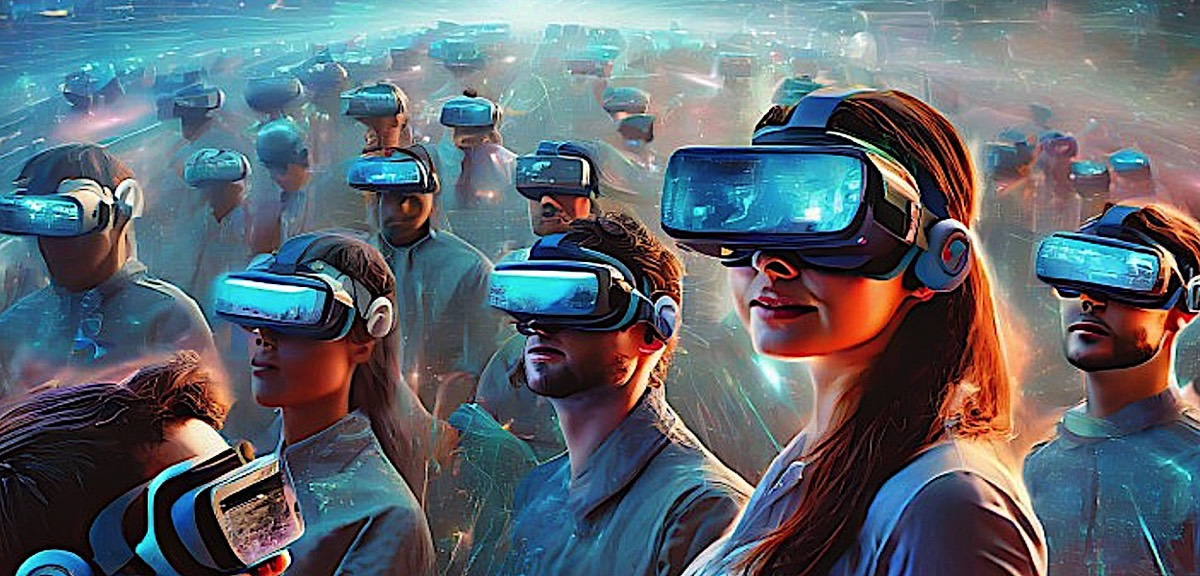

It's a way to describe the intersection between the physical world around us and a virtual world fabricated by technology, while enabling humans and machines to harmoniously manipulate objects and spaces. It’s the purest form of “blending technology into the world”
iTechnologyINT.com

What is Spatial Computing ?
Spatial Computing merges computers and the physical world. This computing revolution takes the next step on technology’s path towards smaller, less visible interfaces, making spatial computing unobtrusive and organic. It’s the purest form of “blending technology into the world”
iTechnologyINT.com

As its name implies, spatial computing combines how humans use and relate to their environment (or space) by incorporating technology into the spaces people naturally occupy. By blending computers with the environment, efficiency and productivity are increased.
How Does Spatial Computing Work?

Spatial Computing merges computers and the physical world. This computing revolution takes the next step on technology’s path towards smaller, less visible interfaces, making spatial computing unobtrusive and organic.
iTechnologyINT.com
Similar to how artificial intelligence (AI) mimics human behavior, spatial computing also strives to replicate human actions and thought processes in physical space. Spatial computing is a bridge between the material and digital worlds. But how does it do this? In short, spatial computing uses integrated technology to mirror how people interact with the 3-dimensional world
Observation

A 3-D model of the world is captured by technology such as photogrammetry, radar, and lidar. Radar and lidar use radio waves or laser reflections that bounce off objects to measure distance. Photogrammetry creates 3-D models from photos and can blend images from multiple sources, like a camera. Newer AI technology like neural radiance fields (NeRF) is also used here.
Analysis
AI techniques come into play in this step, where the gathered data can be analyzed. Machine vision is a popular analysis technique for identifying objects and looking for problems, patterns, or more data.
Action
Next, an action step is determined. For example, when a self-driving car detects a pedestrian and stops to avoid an accident, this is spatial computing taking action. This action, however, is determined by the information sensed in the first step and analyzed in the second step.
Applications of Spatial Computing

Here are some of the applications of spatial computing.
iTechnologyINT.com
Physical Products:
Self-driving cars that operate in the physical world and respond to outside stimuli are only one example of spatial computing at work. Immersive technology, like the ever-evolving Virtual Reality (VR) headset, continues to rise in popularity, creating applications beyond entertainment. Bank of America is testing XR (a combination of Virtual and Augmented realities) technologies in their trading rooms, where users can see a 3D flow of live information.
Industrial:

Spatial computing can help companies optimize every step of the manufacturing process. Interactions between machines and people are refined, increasing speed, productivity, and safety. Spatial computing bridges the gap between physical automation and robotic process automation. For example, a worker can more accurately program a robotic arm using an AR interface. And once those products are manufactured, spatial computing is hard at work in warehouses worldwide. Spatial computing has many valuable applications in the warehouse, including suggesting efficient workflows to prevent employee burnout.
Healthcare:

While there are many applications of spatial computing in healthcare, a prominent example is ProjectDR, developed by the University of Alberta. ProjectDR is an Augmented Reality (AR) device that allows doctors to project diagnostic images onto a patient's skin. ProjectDR automatically takes into account skin texture, contours, and patient shape and projects an accurate image for each patient. ProjectDR can be used during surgery, conservative care like injections, and education for patients and medical students.
Advantages of Spatial Computings

Many advantages come with the use of Spatial Computing.
iTechnologyINT.com
Driving and Navigation
Driving and Navigation are made easier and safer with spatial computing. Navigation applications utilize GPS and other sensors to provide efficient, accurate directions and real-time information about traffic hazards such as accidents or construction. There are billions of GPS devices in use today.
Education

There are many exciting applications of spatial computing in education. VR or AR technology creates an engaging, immersive experience that accelerates learning in various fields, from history to science. These applications are also relevant in many areas where education is essential, such as medicine and manufacturing.
Retailers
Retailers are embracing the advantages of spatial computing to engage with customers in brick-and-mortar and online shopping environments. Retailers with physical locations are using spatial computing to track customer movements and provide real-time customized recommendations. Online retailers are using Spatial Computing and VR/AR technology to allow customers to virtually “try on” clothing, accessories, and makeup. Larger items, such as furniture or television sets, can be virtually arranged in a customer's home, making it easier to tell how well an item fits.
Architects and Designers
Spatial Computing supports the optimal design of physical spaces. Architects and Designers use them to create virtual designs of building projects. These virtual models assist every step of the design process, including any revisions. Architects and designers can examine changes to a construction plan on the virtual model, and errors are revealed in the design stage rather than the construction phase, resulting in lower project costs.
Trends in Spatial Computing

Many advantages come with the use of Spatial Computing.
iTechnologyINT.com
Augmented, Virtual, Mixed Realities (AR/VR/MR). AI Vision
Many of the trends in spatial computing have to do with its application in Augmented, Virtual, and Mixed Realities (AR/VR/MR). Fueled by AI Computer Vision, this arena is seeing significant development. Applications of these technologies are gaining widespread acceptance beyond the gaming industry. Museums are embracing various forms of VR as touring aids, using them to enhance the visitor experience.
Education and Training

Education and Training in all industries and fields can benefit from spatial computing through virtual reality simulations and mixed-reality design. Creating a realistic and engaging teaching environment creates valuable learning opportunities for students of all stripes. These environments are beneficial for teaching skills like surgery or working in dangerous industrial conditions.
Increasingly Sophisticated 3-D Images

Increasingly sophisticated 3-D Images created with spatial computing will assist with activities such as urban planning. Urban populations are projected to increase by billions over the next several decades, and spatial computing is poised to play a significant role in developing new urban areas and repairing existing infrastructure. With its various technologies, such as geospatial mapping, spatial computing is ideally suited to support an activity inherently oriented around spaces and how we use them.
Spatial Computing is Disruptive

Spatial Computing is already part of everyday life and is slated to continue growing in leaps and bounds.
iTechnologyINT.com
Businesses can become early adopters of these new technologies and gain a competitive advantage. Reach out to the spatial computing experts at Encora for more information on how to benefit from this new and exciting technology.
The Future is already here!

Spatial Computing is already part of everyday life and is slated to continue growing in leaps and bounds.
iTechnologyINT.com
Spatial Computing And Why It Will Work This Time

Virtual Reality isn't a novel concept. I remember stepping into a headset at a cybercafe in Palo Alto back in the late '90s, becoming Pac-Man. It was very cool. Later, Google Glass introduced the idea of widely adopted augmented reality, but traditional eyeglasses remain the only widely accepted AR.
However, things are on the verge of a significant shift.
Brandon Guertner
Enter the Vision Pro.It's poised to transform culture akin to the iPhone. This isn't just the most significant cultural shift since the iPhone; it's akin to the impact of the 1984 Macintosh introduction (I had one). Back then, personal computing seemed far-fetched, but look at where we are now.
What sets this apart?
It's about thinking differently. Hello, World.
The true distinction lies in its practicality. Beyond gaming or exploring metaverses (although that's part of it), imagine infinite monitor space, seamlessly transitioning from AR to VR. The potential for remote work and connecting with others in real-time is limitless. Others will undoubtedly emulate the Vision Pro—Microsoft, Google, Samsung.
Spatial computing, merging real-time AI, practical applications, and even—dare I say—cryptocurrency. Not to mention creating visual and functional wonders using Adobe and Apple software.
What sets this apart?
It's about thinking differently. Hello, World.
The true distinction lies in its practicality. Beyond gaming or exploring metaverses (although that's part of it), imagine infinite monitor space, seamlessly transitioning from AR to VR. The potential for remote work and connecting with others in real-time is limitless. Others will undoubtedly emulate the Vision Pro—Microsoft, Google, Samsung.
Spatial computing, merging real-time AI, practical applications, and even—dare I say—cryptocurrency. Not to mention creating visual and functional wonders using Adobe and Apple software.
Apple’s first Spatial Computer: Apple Vision Pro

Apple Vision Pro isa revolutionary Spatial Computer that seamlessly blends digital content with the physical world, while allowing users to stay present and connected to others.
Apple.com
Apple Vision Pro creates an infinite canvas for apps that scales beyond the boundaries of a traditional display and introduces a fully three-dimensional user interface controlled by the most natural and intuitive inputs possible — a user’s eyes, hands, and voice. Featuring visionOS, the world’s first spatial operating system, Vision Pro lets users interact with digital content in a way that feels like it is physically present in their space.
⭐Technology

Technology is important in our lives because it helps to deal with every day's dynamic things. Technology offers various tools to boost development and to exchange information. Both these things are the objective of IT to make tasks easier and to solve many problems.
⭐ AI Artificial Intelligence

Artificial Intelligence is probably the most complex and astounding creations of humanity yet. And that is disregarding the fact that the field remains largely unexplored, which means that every amazing AI application that we see today represents merely the tip of the AI iceberg
⭐ Latest Technology

The latest Technology Information about the world's best trends, hardware, apps, and much more. From top companies like Google and Apple to tiny startups.
PALACE-iConsulting.com
⭐ Future

The American public anticipates that the coming half-century will be a period of profound scientific change. This is among the main findings of a new national survey by the Pew Research Center and Smithsonian magazine, which asked Americans about a wide range of potential scientific developments—from near-term advances like robotics and bioengineering, to more “futuristic” possibilities like teleportation or space colonization.
iConsultingINT.com
Follow Us for the latest International Information and News:

